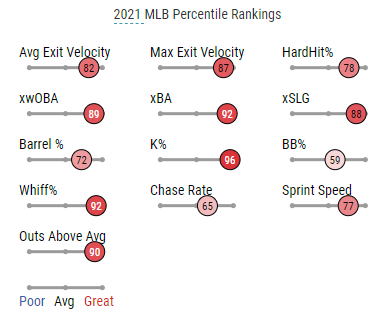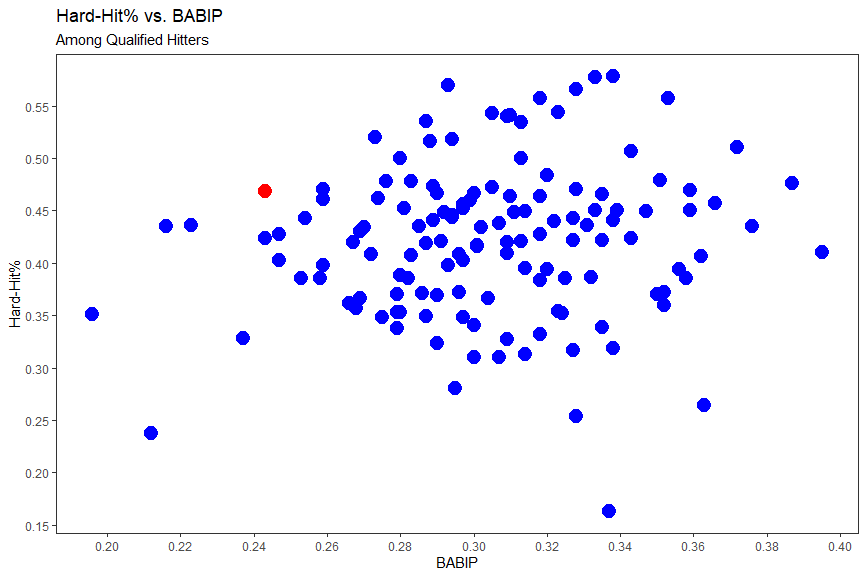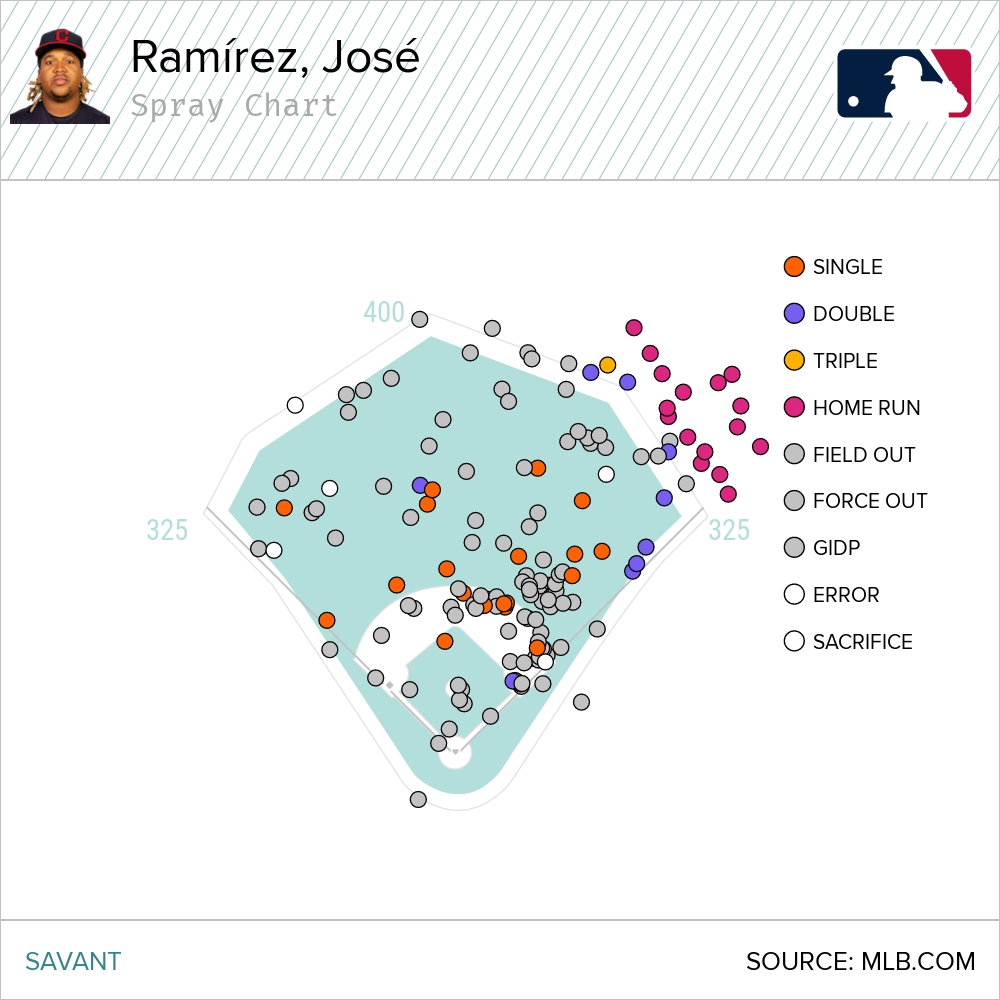One of the themes of the Cleveland season so far this season has been their underperforming lineup. As a unit, they rank 27th in the league in terms of wRC+ at just 86, and they’ve been shuffling in many hitters into their lineup over the course of the season to try and get any sort of offensive spark. Cleveland’s underperformance, however, hasn’t been the fault of José Ramírez. He’s been the biggest and steadiest rock in a shaky lineup, and he has maybe flown a bit under the radar this season. He’s doing his usual mashing, with a solid 130 wRC+ and a .264 isolated power mark, and he leads the team with three wins above replacement – over a win and a half higher than the next-highest player.
Ramírez just does so many things well, which is what makes him such a valuable player. This is likely just a review, but to sum up: he hits the ball hard, he puts it in play, he’s fast, and he plays good defense. And he also does all of that fine hitting while also being a switch-hitter, which is not an easy feat. There’s very little to complain about when talking about Ramírez ’s profile. His Statcast profile showing percentile ranks pretty much shows what it is I’m talking about:

It is red everywhere, and he just simply isn’t below average in anything, while also being elite in certain areas. We see the standout contact ability with his percentile ranks in both strikeout rate and whiff rate, and we see his strong batted-ball skills in the hard-hit, barrel, and exit velocity categories, along with him grading out well defensively and in terms of sprint speed. It’s certainly clear that Ramírez does pretty much everything well.
As it turns out though, Ramírez is even doing some things better this season than in the past. It’s interesting because if you recall, Ramírez finished second in MVP voting last year, and also has two other top-three finishes to his name, so it seems hard to believe that Ramírez could perhaps top what he has accomplished at the plate in the past, but he is doing that in a lot of areas this year.
First off, Ramírez is hitting the ball harder. His 47% hard-hit rate would be a new career-high and is over ten percent higher than his previous best mark. To go along with that, his average exit velocity is also a new career-high, and he has continued to barrel up balls at a solid rate, matching last year’s high 10.2% with a similarly strong 11.2% this year. And while he’s never had a strikeout issue, he’s somehow even striking out less this season, at just 13.1, which would be his lowest rate since 2017 and is just a super low rate for a hitter who hits the ball as well he does. Add all of that up, and his expected metrics end up being through the roof as would be guessed considering all of the red in the aforementioned Statcast image. All three of his expected slugging, wOBA, and wOBA on contact are career-highs for him right now, which would have seemed hard to top considering his track record.
However, despite everything standing out and looking positive when it comes to the Statcast metrics, it does seem like his batting line is a little low for someone with such a glowing profile. Not that there is anything inherently bad about his actual results so far this year – they’re quite good – but still, they are maybe a little underwhelming, as well as a little odd.
Probably the oddest thing about his season to this point has to do with his BABIP. At just .246, it’s low, and extremely so for a hitter of his caliber. Among qualified hitters, Ramírez’s BABIP is one of the ten-lowest, and when looking at the other hitters in the bottom-ten, Ramírez is quite clearly the one that stands out the most:
Pretty much all of the hitters in this group are either having bad years, or are roughly league-average, yet Ramírez is still producing at a high rate despite such a low BABIP, which seems impressive. We can also see how much of an outlier Ramírez is when comparing the BABIPs of all qualified hitters to their hard-hit rate, for instance:

Ramírez is the point in red, and it does look like Ramírez is something of an outlier here. Among hitters with a BABIP lower than .280, only three hitters: Pete Alonso, Kyle Schwarber, and Adam Duvall have a higher hard-hit rate than Ramírez. For Ramírez, his current .246 BABIP would be his lowest since 2015’s .232 mark in just 97 games, and remember, he wasn’t this version of himself that we now know and love back then – he had just a 72 wRC+ and a .121 ISO that year – he was a completely different player.
Now, it may seem simple to just think that his BABIP, being super low and with excellent Statcast metrics, should come up some and bounce back to normal going forward. It is true that it should likely come back up in the future, but it probably isn’t that simple. Sometimes it’s true that a hitter’s BABIP being too high or low has to do with luck, but that’s not always the case. Bad luck may have something to do with it when it comes to Ramírez, but it also seems like something fishy is going on here too.
When trying to evaluate what’s going with Ramírez in this department, it makes sense to start by looking at his performance from both sides of the plate. When looking at his splits by handedness, we see that he’s been productive from both sides of the plate, but more so as a lefty:
While Ramírez has been good from both sides of the plate, his path to production has definitely been different. As a righty, he looks more like a higher-average, lower-power type of hitter, and more of a traditional slugger as a lefty. Not that one type of hitter is better than the other, but perhaps the argument could be made that Ramírez has been more of a “complete” hitter as a righty this season.
But it’s not as if Ramírez has just been a different type of hitter from one side of the plate compared to the other. He’s hitting the ball similarly, and actually, nearly identical from each side:
While the expected stats view Ramírez more positively as a lefty, the barrel rate is identical, the hard-hit rate is a tick off, and he’s not striking out much more as a righty (some of the difference in the expected stats seems to come from him hitting a lot more pop-ups as a righty – 19% infield fly ball rate vs. an 8.3% rate as a lefty). So again, Ramírez doesn’t seem to be a very different hitter at all from either side of the plate, but even with that being the case, it has come with a completely different BABIP profile, with him having a BABIP over 100 points lower as a left-handed hitter:
Overall, among all of the other qualified left-handed hitters, Ramírez’s .204 BABIP is the lowest. His BABIP as a righty isn’t anything out of the ordinary as a righty, with his .315 mark ranking comfortably inside the top-40% among all qualified righties.
Now, some of this is probably due to just plain old bad luck. Going back to his near-MVP season last year, it wasn’t this extreme, and going back further, Ramírez has never had this drastic of a BABIP difference depending on what side of the dish he’s standing on:
Going back to 2016, Ramírez generally has had a higher BABIP as a righty, but the differences have never been this stark. So sure, some of it may be a matter of bad luck, but there’s probably also more to it than that.
One thing that has been generally trending up for Ramírez over the years has been his pull rate, especially as a left-handed hitter, which likely corresponds to a certain amount to his gains in the power department in that span. Compared to 2016, for instance, Ramírez’s pull rate is 20% higher now than it was then:
While Ramírez’s overall pull rate has been hovering close to 50% since 2018, it really has reached a new level this season, as he has transformed into an extreme pull hitter, with a pull rate of nearly 60%, and from both sides of the plate to boot, with not much of a difference from either side of the plate. In the end, Ramírez has the game’s highest pull rate, and he’s pretty set in the top spot:
With the book on Ramírez pretty much set right now, the obvious move for opposing teams would be to position their defense into a shift for Ramírez. Now, right-handed hitters generally get shifted less than lefties do, and Ramírez may not be the most prime target for a shift as a righty due to his still-excellent speed, but he still is being shifted around 20% of the time as a righty. It’s not the highest amount, but it is still up about 14% from where it was in 2018, for instance. It’s a completely different story as a lefty though. This year, teams are shifting against lefty Ramírez at a crazy high rate, and a rate that is over 20% higher than it was just two years ago:
It’s definitely a drastic increase, and as for how that compares to the rest of the league, there’s only one other left-handed hitter who has seen a higher rate of shifts this season:
Now, Ramírez is still generally performing well when he faces a shift – his wOBA when he faces a left-handed shift is .372, but as we know, his BABIP is severely lagging as a lefty. That’s likely to do with him having all of his home runs as a lefty go the pull-side. See his left-handed spray chart for reference:

Of course, home runs aren’t reflected in BABIP, which likely explains a good bit of the reason as to why his left-handed BABIP is so low. Thankfully for Ramírez, he’s able to hit the ball so hard, which has led to so many home runs as a lefty, with a top-ten home run per fly ball rate among lefties at 22.2%, which keeps him productive as a lefty overall, because it looks like all of the extra shifts he’s seen has killed a lot of his results elsewhere. Take, for example, these balls all hit greater than 108 miles-per-hour, but sucked into the shift:
Those are just three examples, but it’s been a theme all season for Ramírez, as he’s running one of the lowest batting averages on groundballs among lefties this season, with the shift likely being a big reason why:
Now, fortunately, Ramírez doesn’t hit many groundballs (34% as a lefty, 35.5% overall), but this definitely has had an impact on his overall results, and more specifically, his left-handed BABIP.
While this maybe isn’t the slash line and overall path to production we would have expected from Ramírez, he is still a productive hitter, it’s just come in a different way. Sure, his batting average is down as a lefty, but he is making up for it with a higher rate of home runs:
I would guess that as long as Ramírez continues to hit the ball hard – which he has shown consistently the last handful of years, and especially so this year– that he will, generally, remain a productive hitter as a lefty, even with an extreme pull-heavy approach that leads to one of the highest rates of infield shifts. He may be getting unlucky and have some hits taken away from him, but I do think that this is actually a positive development for Ramírez. He is staying true to who he is naturally as a hitter, and perhaps even doubling down on it, as his pull rate is the highest it’s ever been this season. He’s not trying to adopt a “beat-the-shift” type of approach, which he infamously tried in the back-half of 2018 through around the mid-point of 2019, which did not work out for him.
Ramírez is clearly at his best when he pulls the ball. He’s sticking with it, and not trying to change the type of hitter he is, despite some results that I’m sure can be quite frustrating. He’s already doing the tough part of the job right, in that he hits the ball super well and puts it in play. While his BABIP as a lefty is low right now, if he can keep consistently hitting the ball as he has through the first half of the season, I would bet on it climbing some going forward. It may not reach its one-time highs, but hitting the ball hard usually leads to good things happening more often than not. We don’t want to see a repeat of what happened to Ramírez in late-2018 through mid-2019 again. With him sticking to his true approach and natural self as a hitter, we probably won’t.
Photo from KeithAllisonPhoto.com and Erik Drost | Design by Quincey Dong (@threerundong on Twitter)

